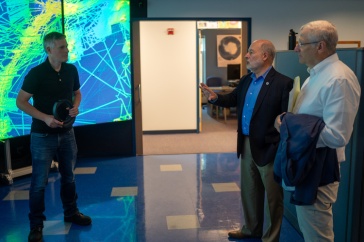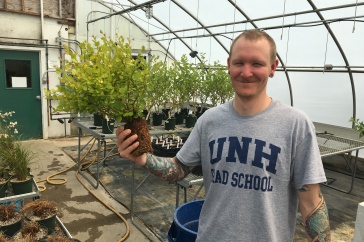
Each summer, a handful of UNH researchers pass up New England’s hard-won summer and head to the remote glaciers, peatlands and oceans on top of the world. There, they’re exploring the Arctic’s outsized influence — and impact — on the Earth’s changing climate.
“The Arctic is the canary in the coalmine,” says research professor Cameron Wake of UNH’s Institute for the Study of Earth, Oceans, and Space (EOS). The region is warming faster than the rest of the globe, he says, and its thawing has major implications for all of us.
Wake and others are probing climate change’s powerful impact on what’s called albedo, a measure of reflectivity off the Earth’s surface. Like a white t-shirt on a hot day, snow and ice reflect heat back into the atmosphere.
“All you need to do is melt a little snow and expose a dark surface, or melt a little sea ice and expose dark water, and that ocean or terrain absorbs more solar radiation, and that heats up the earth even more, and melts a little more snow and ice in what becomes a vicious circle,” says Wake, the Josephine A. Lamprey Professor in Climate and Sustainability.
With decades of work in Greenland behind him, Wake’s colleague and EOS research associate professor Jack Dibb has recently turned his attention to the role of black carbon — soot — in that ice-albedo feedback loop. Theorizing that this by-product of incomplete combustion of organic materials, emanating from burning diesel fuels as well as from wildfires and other biomass, is darkening the snow and ice and lowering its albedo, Dibb and his colleagues found the effect is more complex.
“We’re showing that at the high elevations of the Greenland ice sheet, there is so little dust or black carbon in the snow that it makes a minimal difference in the albedo,” he says of results published recently in the journal Geophysical Research Letters. The study showed that degrading satellite sensors, not soot, were responsible for the apparent decline in albedo. Melting and exposed water at lower elevations, the researchers suspect, are far greater drivers of Greenland’s darkening.

While Dibb’s work takes in satellite imagery of the surface of ice, Wake goes beneath the snow — 700 feet beneath — to chronicle a millennium of climate history. In 2013, he, Elizabeth Burakowski ‘13G (now a postdoctoral researcher), and a National Science Foundation-funded team that included University of Maine and Dartmouth researchers spent late spring in Alaska’s Denali National Park drilling ice cores from the Mt. Hunter Plateau at 13,000 feet.
“Thirty percent of the soil carbon on the Earth is locked up in these permafrost soils. When that thaws, these soils can change from being a carbon sink to a source.”
Ice cores are, says Wake, arguably the best archive of how our climate system has changed over the course of the last centuries, millennia, out to hundreds of thousands of years. The cores from Denali, which complement previous UNH collaborative coring efforts across the Canadian Arctic, point to a warming climate.
“What is very clear in the record is that we see a lot more melting in recent years compared to previous centuries,” says Wake.
In the permafrost peatlands of northern Sweden, associate professor of biogeochemistry Ruth Varner leads work on the impact of climate change on vegetation and carbon cycling. In the six summers she’s done fieldwork at the Abisko Scientific Research Station, she’s seen significant changes in the amount of thaw happening there. “We’re seeing greater methane emissions in systems that are thawing versus those that are frozen,” Varner says.
And not only are these thawing peatlands emitting more methane — a greenhouse gas twenty times more potent than carbon dioxide — they’re no longer storing carbon. “Thirty percent of the soil carbon on the Earth is locked up in these permafrost soils. When that thaws, these soils can change from being a carbon sink to a source,” she says.

Her work there taps other UNH expertise: Varner takes half-meter sized plot measurements of vegetation, species composition and methane emissions; associate professor Michael Palace — like Varner, co-appointed to EOS and the department of Earth sciences — uses remote sensing and drones to scale these up to ecosystem-wide models.
It’s not just thawing vegetation that is guilty of methane emissions: In a study published in Nature Geoscience in January 2016, Varner and co-authors found that freshwater lakes and ponds above the 50th parallel are one of the largest natural sources of methane. And a warming climate will make the scenario worse, she says; if ice-free seasons are extended by 20 days, annual methane emissions from the 733 ponds and lakes studied will increase by 20 to 54 percent by the end of the century.
Climate news from the top of the world is not all dire, however. From a research ship plying the Fram Strait between Norway and Greenland, geologist and associate professor Joel Johnson identified a previously undiscovered reservoir of methane that is “locked” away from the atmosphere, where it could change the climate. “This work shows there are parts of the Arctic where methane is coming up to the seafloor and instead of coming out, it is trapped in gas hydrates; it’s finding itself in a stable environment for millions of years,” he says.
And University Professor of environmental engineering Nancy Kinner, whose UNH/National Oceanic and Atmospheric Administration Coastal Response Research Center has been convening stakeholders to prepare for oil spill response in the Arctic since 2008, breathed a cautious sigh of relief when Royal Dutch Shell abandoned its plans for exploratory drilling in September.
“The good news is, we’re not going to drill in Arctic waters,” she says. On the other hand, warming waters and melting ice has made the Arctic ever more accessible to shipping. “There’s a real potential for catastrophe,” says Kinner, adding that a spill in these harsh, remote waters will challenge responders and endanger a fragile environment.? “Most ships carry some kind of fuel, and this is a region where organisms live by the skin of their teeth.”
?
Recognizing Arctic Researchers
A Model Mentor

At the American Geophysical Union meeting in San Francisco in December, Ruth Varner received that organization’s 2015 Sulzman Award for Excellence in Education and Mentoring. The award recognizes not only Varner’s research but also her extraordinary record of mentoring students, especially undergraduates and women. As director of the international Northern Ecosystems Research for Undergraduates (NERU), the NSF-funded program based at UNH, Varner has taken 37 undergraduates from colleges around the nation to Sweden to cut their teeth on state-of-the-art climate change field research; all seven of this year’s students presented their research at the AGU meeting. And back on campus, Varner directs UNH’s Joan and James Leitzel Center for Mathematics, Science and Engineering Education, which taps UNH research resources to transform K-12 STEM education programs.
Fine Fellow

Biogeochemist Steve Frolking was named a fellow of the American Association for the Advancement of Science (AAAS) in recognition of his contributions to understanding the Earth’s carbon cycle and its relationship to climate. Frolking leads a computer modeling project that spans 18 countries and encompasses all of Central, South, East and Southeast Asia, where some 1.3 billion people depend upon the waters that spring from the Tibetan Plateau. Honored at a ceremony at the annual AAAS meeting in February 2016, Frolking is UNH’s fourth AAAS fellow, joining space physicist Nathan Schwadron, biochemist Stacia Sower and geochemist Samuel Mukasa, dean of the College of Engineering and Physical Sciences.?
?
?
?
?
?
?
?
?
?
?
?
?
?
?
?
?
?
?
?
?
?
?
?
?
?
?
?
?
?
?
-
Written By:
Beth Potier | UNH Marketing | beth.potier@unh.edu | 2-1566




















































